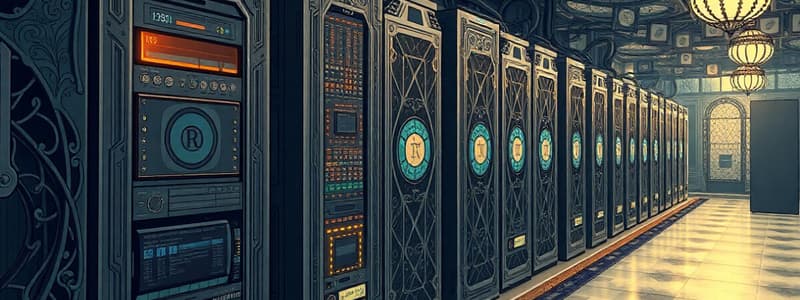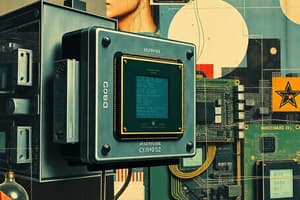Podcast
Questions and Answers
Which of the following is NOT considered an input device?
Which of the following is NOT considered an input device?
- Mouse
- Printer (correct)
- Keyboard
- Microphone
The contents of computer memory are preserved even when the computer is turned off.
The contents of computer memory are preserved even when the computer is turned off.
False (B)
What is the primary function of a modem?
What is the primary function of a modem?
To enable a computer to send and receive data.
A system unit primarily contains the ________ and ________ of a computer.
A system unit primarily contains the ________ and ________ of a computer.
Match the following input devices with their primary function:
Match the following input devices with their primary function:
Which device is commonly used to display information visually?
Which device is commonly used to display information visually?
Storage devices are used to temporarily hold data while the computer is in use.
Storage devices are used to temporarily hold data while the computer is in use.
Name one example of a storage media.
Name one example of a storage media.
What characteristic allows a computer to produce the same results given the same input and processes?
What characteristic allows a computer to produce the same results given the same input and processes?
Wireless transmission media include only cellular radio networks.
Wireless transmission media include only cellular radio networks.
What are the four operations in the information processing cycle?
What are the four operations in the information processing cycle?
The __________ allows computers to communicate and share resources such as hardware and software.
The __________ allows computers to communicate and share resources such as hardware and software.
Match the following characteristics of computers with their definitions:
Match the following characteristics of computers with their definitions:
What is a major health risk associated with improper computer use?
What is a major health risk associated with improper computer use?
What is a primary function of a computer?
What is a primary function of a computer?
Data is the processed output that conveys meaning and is useful to people.
Data is the processed output that conveys meaning and is useful to people.
Individuals have no reason to be concerned about privacy when using computers.
Individuals have no reason to be concerned about privacy when using computers.
What is defined as a collection of related instructions organized for a common purpose?
What is defined as a collection of related instructions organized for a common purpose?
What are the roles of a server in a network?
What are the roles of a server in a network?
The series of activities involving input, process, output, and storage is known as the __________.
The series of activities involving input, process, output, and storage is known as the __________.
Which component of a computer is responsible for displaying output?
Which component of a computer is responsible for displaying output?
Match the following components with their functions:
Match the following components with their functions:
Mobile devices are classified as computers because they can only communicate with other devices.
Mobile devices are classified as computers because they can only communicate with other devices.
What is the term used to describe unprocessed items like text, numbers, and images?
What is the term used to describe unprocessed items like text, numbers, and images?
Flashcards
Input device
Input device
Hardware used to enter data into a computer.
Output device
Output device
Hardware that displays information to the user.
System Unit
System Unit
Computer case containing processing components.
Processor (CPU)
Processor (CPU)
Signup and view all the flashcards
Computer Memory
Computer Memory
Signup and view all the flashcards
Storage Device
Storage Device
Signup and view all the flashcards
Communications Device
Communications Device
Signup and view all the flashcards
Storage Media
Storage Media
Signup and view all the flashcards
Wireless Transmission Media
Wireless Transmission Media
Signup and view all the flashcards
Computer Speed
Computer Speed
Signup and view all the flashcards
Computer Reliability
Computer Reliability
Signup and view all the flashcards
Computer Consistency
Computer Consistency
Signup and view all the flashcards
Network
Network
Signup and view all the flashcards
Server
Server
Signup and view all the flashcards
Client/Workstation
Client/Workstation
Signup and view all the flashcards
Home Network
Home Network
Signup and view all the flashcards
What is a computer?
What is a computer?
Signup and view all the flashcards
Data vs. Information
Data vs. Information
Signup and view all the flashcards
Information Processing Cycle
Information Processing Cycle
Signup and view all the flashcards
Software
Software
Signup and view all the flashcards
Hardware
Hardware
Signup and view all the flashcards
Input Devices
Input Devices
Signup and view all the flashcards
Output Devices
Output Devices
Signup and view all the flashcards
Embedded Computer
Embedded Computer
Signup and view all the flashcards
Study Notes
Introduction to Computer Systems
- A computer system comprises input, processing, memory, and output units.
- The central processing unit (CPU) is composed of the control unit and ALU (arithmetic logic unit), along with registers.
A World of Information
- Computers are ubiquitous in workplaces, schools, and homes.
- Mobile computers and devices are portable.
- Many cell phones are considered computers.
- Computers facilitate global communication for billions.
- They allow instant access to information worldwide.
- Banks use ATMs (embedded computers) for anytime transactions.
- Vehicles have onboard navigation systems (embedded computers).
- People use computers for leisure activities like gaming and listening to music.
What Is a Computer?
- A computer is an electronic device controlled by instructions stored in its memory.
- Accepting data, processing it according to rules, producing results, and storing them for future use are computer capabilities.
Data and Information
- Data refer to unprocessed items like text, numbers, images, audio, or video.
- Information interprets data to convey meaning and is useful for people.
- Computers convert data into information, like a cash register receipt.
Information Processing Cycle
- Computers transform input data into output information.
- Instructions guide computers in carrying out tasks.
- Software consists of organized instructions for a specific purpose.
- The input, process, output, and storage sequence defines the information processing cycle.
- Communication is now a crucial part of the information processing cycle.
Components of a Computer
- A computer is a composite of electronic, mechanical, hardware components.
- Input, output, system unit, and communication devices are among these parts.
Input Devices
- Input devices allow users to enter data and instructions into a computer.
- Common input devices include keyboards, mice, microphones, scanners, and webcams.
Output Devices
- Output devices convey information to users.
- Typical output devices include printers, monitors, and speakers.
Storage Devices
- Storage devices hold data, instructions, and information for future use.
- They maintain data like customer names and addresses.
- Examples of storage media are USB flash drives, hard disks, and memory cards.
- A storage device both records (writes) and retrieves (reads) data to storage media.
- Portable hard disks may be external or removable.
Communication Devices
- Communication devices enable computers to transmit and receive data, instructions, and information with other computers or mobile devices.
- Examples of communication devices include a modem.
- Communication can occur wirelessly, e.g., through radio networks or satellites, and over physical cables and phone lines.
Computer Characteristics
- Computers process data, instructions, and information very rapidly.
- Components are generally reliable and don't often break down.
- Consistency in procedures ensures similar outputs with the same input.
- Storage allows swift data transfer between memory and storage for lasting use.
Computer Networks and the Internet
- A network connects multiple computers for shared resources (hardware, software, data, and information), saving time and money.
- A server controls network resources, while clients (workstations) request them.
- Networks range in size, from small home networks to large global networks spanning cities, countries and the world.
- The Internet is the largest global network interconnecting various other networks, institutions, and businesses.
Internet Usage
- People around the world use the Internet for communication, research, e-commerce, banking, online training, and recreational activities
The Web
- The World Wide Web (WWW) is a globally interconnected service on the Internet.
- Web pages are documents containing links to other data and resources.
- Web applications (e.g., email, online banking, and gaming) provide interactive services available through the Internet.
Computers Misuse
- Excessive or incorrect computer use might cause hand, wrist, neck, eye, and back issues.
- Practicing good posture, using adequate work breaks, and having suitable workstations can mitigate these health concerns.
- Potential misuse risks also include addiction to computers, and technology overload.
Violation of Privacy
- Computers store sensitive information, including medical records and credit reports.
- Data breaches and inappropriate sharing of personal information can violate privacy and lead to identity theft.
Studying That Suits You
Use AI to generate personalized quizzes and flashcards to suit your learning preferences.




